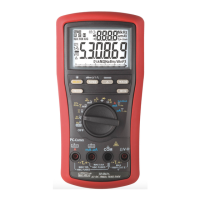2
WARNING
To reduce the risk of fire or electric shock, do not expose this product to rain or moisture. To
avoid electrical shock hazard, observe the proper safety precautions when working with
voltages above 60 VDC or 30 VAC rms. These voltage levels pose a potential shock hazard
to the user. Do not touch test lead tips or the circuit being tested while power is applied to
the circuit being measured. Keep your fingers behind the finger guards of the test leads
during measurement. Inspect test leads, connectors, and probes for damaged insulation or
exposed metal before using the instrument. If any defects are found, replace them
immediately. Do not measure any current that exceeds the current rating of the protection
fuse. Do not attempt a current measurement to any circuit where the open circuit voltage is
above the protection fuse voltage rating. Suspected open circuit voltage should be checked
with voltage functions. Never attempt a voltage measurement with the test lead inserted into
the A/mA or A input jack. Only replace the blown fuse with the proper rating as specified in
this manual.
CAUTION
Disconnect the test leads from the test points before changing functions. Always set the
instrument to the highest range and work downward for an unknown value when using
manual ranging mode.
INTERNATIONAL ELECTRICAL SYMBOLS
!
Caution ! Refer to the explanation in this Manual
Caution ! Risk of electric shock
Earth (Ground)
Double Insulation or Reinforced insulation
Fuse
AC--Alternating Current
DC--Direct Current
2) CENELEC DIRECTIVES
The instruments conform to CENELEC Low-voltage directive 2006/95/EC and
Electromagnetic compatibility directive 2004/108/EC

